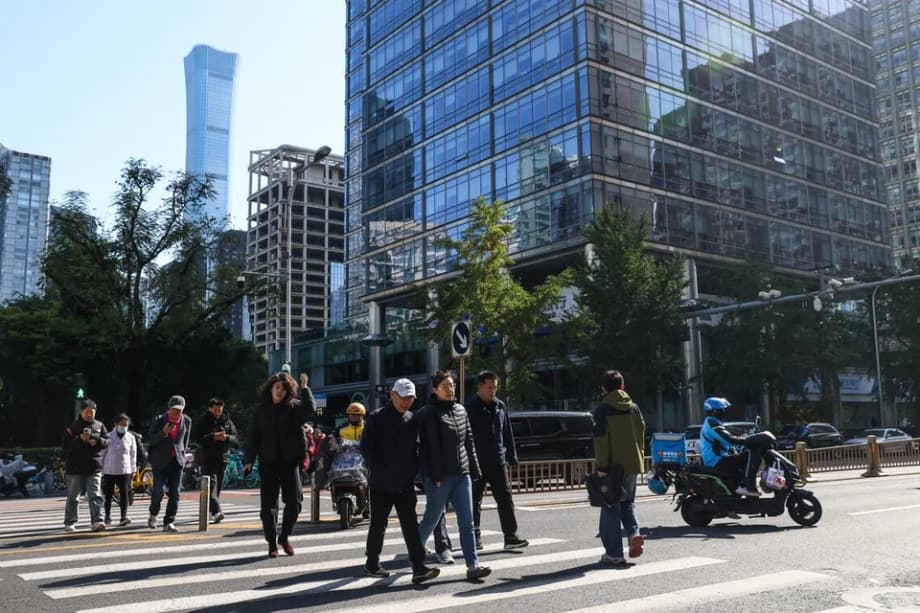A new visitor gateway on the Pearl River Estuary
China has opened the doors, on a trial basis, to a new cultural and tourism site built into one of its most complex transport projects. Starting Oct 25, the western artificial island on the Shenzhen Zhongshan Link is hosting a month long trial for guided visits that showcase the science, engineering and sweeping views of this 24 kilometer cross sea corridor. Entry during the trial is free by reservation, with formal public opening targeted for December.
- A new visitor gateway on the Pearl River Estuary
- What exactly is the western artificial island
- How the trial works and how to book
- What visitors will see and do
- A showcase for a record setting project
- Strong demand from visitors across the bay
- Safety, operations and crowd management
- How it fits into the Greater Bay Area strategy
- What to Know
The island, which covers around 137,000 square meters, sits where the sea bridge meets an underwater tunnel. It serves multiple roles, from traffic management and emergency response to public science education. During the trial, weekday visits are reserved for enterprises and study groups, while weekend slots open to the public. Visitors board designated shuttle buses, test a curated route, and share feedback on exhibits, interactive equipment and services.
Once the site officially launches, tickets are set at 188 yuan for adults, 158 yuan for students, and 128 yuan for children. The price includes round trip transport and a guided experience of about three hours. On site dining and additional services are planned to come online by the end of December.
What exactly is the western artificial island
The Shenzhen Zhongshan Link is a major sea crossing that connects the tech hub of Shenzhen with Zhongshan on the west bank of the Pearl River Estuary. It combines long span sea bridges, two man made islands and an immersed tube tunnel. The corridor opened to traffic on June 30, 2024 after seven years of planning and seven years of construction by more than 15,000 workers, cutting typical road travel between Shenzhen and Zhongshan from around two hours to about 30 minutes.
The western artificial island is the bridge to tunnel transition point, sometimes called a bridge tunnel hub. It houses operational control rooms, a rescue dock and a helipad, and now a public science and education base. An artificial island of this kind is built from scratch in the water to support complex junctions and facilities. Beneath the surface, the link includes an underwater interchange that allows traffic to change direction within the tunnel system. The immersed tube tunnel is formed by large prefabricated steel shell or concrete sections, towed to position, immersed onto a prepared seabed trench, and joined into a watertight conduit with millimeter scale precision.
How the trial works and how to book
The trial runs for one month from Oct 25. Weekdays prioritize enterprise groups and schools, while weekends welcome the general public. Participation is free during the trial period, but a confirmed reservation is required.
Bookings are handled through designated WeChat mini programs with real name registration typically 1 to 7 days in advance. After securing a reservation, visitors board free shuttle buses from specified pick up points in Shenzhen and Zhongshan, with departures at fixed times announced by the organizers.
On arrival, participants check in and join a guided route that covers the central observation deck and the indoor science and education base. Organizers expect the on site experience during the trial to take roughly two to three hours. Once the attraction fully opens, standard tickets will bundle round trip shuttle transport with a three hour tour.
For a smooth visit, plan for coastal weather, wear comfortable shoes and follow marked routes. Photography is welcome in public areas. Access to operational control zones is restricted for safety.
What visitors will see and do
The visit begins with the observation deck at the heart of the island. From here, guests get unobstructed views of the sea bridge, shipping lanes and the flight paths around Shenzhen Baoan International Airport. On clear days, aircraft movements and long sequences of vehicles crossing the bridge offer a dynamic panorama of the Greater Bay Area at work.
The science and education base
The indoor exhibition space covers about 2,200 square meters and uses virtual reality, augmented reality and holographic projection to bring the project to life. Visitors can follow a simulated journey that shows how crews aligned tunnel segments, how sea bridge cables were anchored, and how the underwater interchange fits into the overall design. The digital experiences turn abstract engineering principles into concrete scenes that are easy to grasp.
Exhibits explain practical challenges faced by builders on the Pearl River Estuary, including narrow weather windows around typhoons, strong currents and high salinity. Interactive displays walk through the towing of an immersed tunnel section, its lowering to a prepared seabed foundation, and the final precision jointing and sealing that keeps the tunnel dry and safe.
Outdoor engineering displays
Outdoors, full scale test sections from the underwater tunnel are on display. Seeing a real sized steel shell segment at ground level helps visitors understand the scale and detail of immersed tube construction, from the gaskets and shear keys at a joint to the ballast inside a segment that keeps it stable on the seabed.
Other components on view illustrate how a long span suspension bridge deals with wind, salt spray and constant motion. Cable clamp assemblies, sample anchor blocks and expansion joints show how forces are managed while keeping the driving surface smooth enough for high speed traffic.
Wayfinding panels and labels in Chinese and English guide the route. Staff and volunteers are on hand to explain exhibits and answer questions.
A showcase for a record setting project
The Shenzhen Zhongshan Link stretches 24 kilometers with eight lanes and a design speed of up to 100 kilometers per hour. With an estimated cost of 44.69 billion yuan, the project overcame typhoons, humid and saline conditions and deep silt layers on the seabed. It set multiple world records in suspension bridge engineering, navigable clearance over sea channels and large scale anchor systems.
Construction teams introduced new tools to raise efficiency and safety. One example is an integrated intelligent tower crane developed for the sea bridge, which lifted tower columns at a pace reported at about 1.2 meters per day. The approach cut the need for high altitude work and increased productivity compared with traditional methods.
Industry peers have taken notice. The bridge has received a George S. Richardson award from the International Bridge Conference, a recognition given to projects that combine technical excellence with practical achievement.
The link strengthens the one hour transport circle in the Guangdong, Hong Kong and Macao Greater Bay Area. By creating a direct highway between the east bank engines of Shenzhen, Dongguan and Huizhou and the west bank corridor of Zhuhai, Zhongshan and Jiangmen, the corridor improves the flow of people and freight and balances growth across the estuary.
Strong demand from visitors across the bay
Interest from residents across the region has been strong since the link opened to traffic in mid 2024. When group tours first began running via the new corridor, agencies quickly filled seats for early trips, reflecting curiosity about the sea bridge, the tunnel and the communities on the west bank of the Pearl River.
Usage data back up the enthusiasm. In the first year of service to June 30, 2025, more than 31.5 million vehicle trips crossed the link, an average of about 86,000 per day. Traffic reached a single day peak of 181,600 vehicles on the first day of the 2025 May Day holiday.
The corridor has also supported public transport and air travel access. In one year, about 120,000 intercity bus trips ran between Zhongshan and Shenzhen, carrying roughly 3 million passengers. Around 940,000 travelers from the west bank used the link to reach Shenzhen Baoan International Airport, a rise of about 160 percent over pre opening levels.
Tourism on the west bank has surged. During the 2024 National Day holiday, Zhongshan welcomed about 3.41 million visitors and generated tourism revenue of 1.968 billion yuan. The new island attraction aims to channel some of that momentum into science education and cultural sightseeing tied to the mega project.
Yuan Moli, an employee at Shenzhen Xinyichang Technology, described how the new route changed a regular commute between facilities.
“The new transport link is a golden avenue for us, cutting the travel time between our R&D center in Shenzhen and our factory in Zhongshan to half an hour.”
Safety, operations and crowd management
Even as it opens to visitors, the island remains a live operations hub for the highway. To protect both traffic operations and guests, access is by reservation only, movements follow marked paths, and private vehicles are not permitted on the island during tours. The site includes a helipad and a rescue dock that serve emergency response needs for the sea crossing.
Facilities for visitors are rolling out in stages. Rest areas, shade and restrooms are available, and food and beverage services are planned to start by the end of December. Organizers advise checking weather forecasts for wind, rain and sun when planning a visit, as the island is exposed to coastal conditions.
The reservation system uses real name registration to manage capacity and security. Always bring the identification used for booking, arrive early at your shuttle pick up point, and follow staff instructions while on site.
How it fits into the Greater Bay Area strategy
The Shenzhen Zhongshan Link is part of a wider push to build a dense and efficient network across the Greater Bay Area. It sits roughly 31 kilometers north of the Hong Kong Zhuhai Macao Bridge and complements an expressway grid that now extends beyond 4,500 kilometers. The region, which includes Hong Kong, Macao and nine Guangdong cities, produced more than 14 trillion yuan of economic output in 2023.
City leaders view the corridor as a catalyst for business ties and industry collaboration. Shenzhen and Zhongshan have outlined plans to build an advanced manufacturing cluster, expand modern services, and develop a more integrated industrial system that benefits both banks of the estuary. Shorter trips, predictable travel times and new cross river routes support these goals.
The tourism trial on the artificial island adds a public facing dimension to that strategy. It turns a major infrastructure node into a classroom and lookout point, where families, students and professionals can learn how bridges and tunnels are built and maintained. Future programs, including boat tours to view the bridge from the sea and low altitude sightseeing flights, are being studied to broaden the visitor experience.
What to Know
- Month long trial starts Oct 25 with free entry by reservation, and a formal opening is planned for December.
- Weekdays prioritize enterprise and school groups, weekends are open to the public by booking.
- Post opening tickets are 188 yuan for adults, 158 yuan for students aged 6 to 17, and 128 yuan for children aged 5 and under or under 1.2 meters in height.
- Tickets include round trip shuttle transport and an approximately three hour guided tour.
- Reservations use real name registration via designated WeChat mini programs, typically 1 to 7 days in advance.
- Shuttle buses depart from selected locations in Shenzhen and Zhongshan at fixed times.
- Highlights include an observation deck with views of Shenzhen Baoan International Airport and the sea bridge, a 2,200 square meter science and education base with VR, AR and holographic experiences, and outdoor full scale tunnel test sections.
- The island spans about 137,000 square meters and supports traffic management, emergency rescue and public education for the corridor.
- The Shenzhen Zhongshan Link is 24 kilometers long with eight lanes at up to 100 kilometers per hour, cutting travel time between the two cities to around 30 minutes.
- In its first year, the link recorded more than 31.5 million vehicle trips, while tourism and intercity travel across the west bank rose sharply.
- Future add ons under study include boat tours around the bridge and low altitude sightseeing flights, with dining and more leisure services expected by the end of December.




